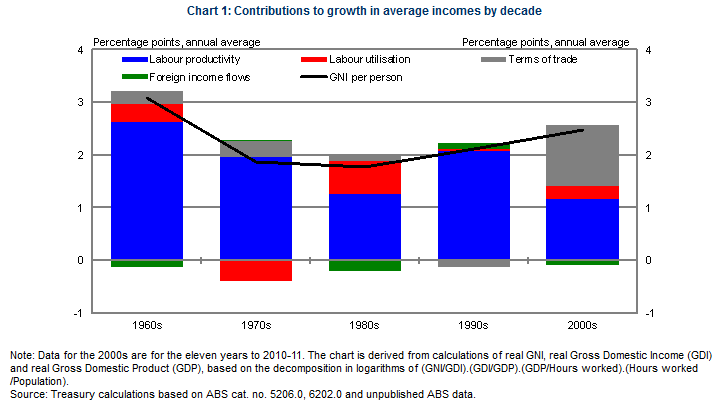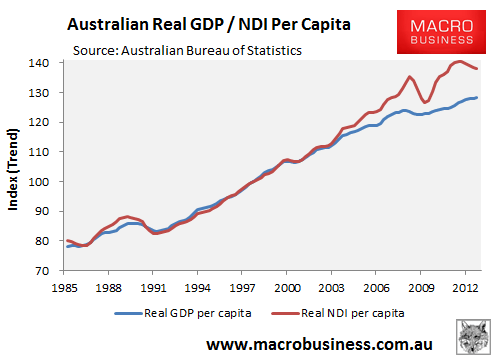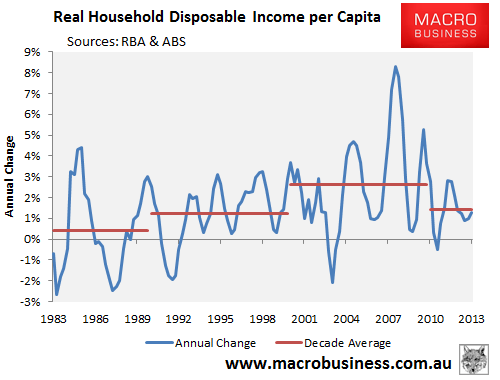
In early 2003, I joined the Australian Treasury where I was immediately introduced to the Department’s “Three P’s” framework, which effectively argued that Australia needed to: 1) boost productivity; 2) raise workforce participation; and 3) increase the population via skilled migration, if the nation was to continue to enjoy rising living standards.
Being a young fella at the time, and fairly green in my thinking, I didn’t think to much about the framework and accepted it more or less as gospel.
Now in my mid-30s, and arguably wiser, I have come to realise that two planks of Treasury’s framework are questionable: namely that rising workforce participation and an increasing population necessarily raises living standards.
Life is all about trade-offs. Working longer hours (increasing participation) means that less time is available for other pursuits, such as relaxing or meeting-up with friends. So while working more will, other things equal, raise incomes and GDP, it also takes away from the other pleasures in life, placing a question mark over whether living standards are actually improved.
Population growth’s impact on living standards is even more spurious. While it certainly does raise headline GDP (more inputs equals more outputs), there are significant doubts over whether it raises per capita GDP, while also placing greater pressure on the environment, pre-existing infrastructure and housing, and Australia’s fixed endowment of mineral resources (see here for a detailed run-down of the issues).
This leaves productivity growth – effectively producing more from less – as the only real driver of rising living standards over the longer-term.
The Productivity Commission seems to agree with my thinking, claiming that Australia’s living standards are set to fall unless it embarks on a major program of productivity boosting micro-economic (structural) reform. From The Australian:
AUSTRALIA faces decades of slow growth unless the Abbott government commits to a program of reform as far reaching as those of the governments of the 1980s and 90s, the Productivity Commission chairman has warned.
Peter Harris called on the Coalition to make a formal statement setting out its reform agenda in an effort to galvanise business and community expectations…
Mr Harris said that if Australia could not lift productivity above the level of the past decade, it would achieve income growth per person of only 0.5 per cent a year.
This would be lower than at any time in the memory of the working population.
Even if a return to the long-term productivity growth rate of 1.6 per cent were achieved, this would still translate to a halving in income growth from that achieved during the past 50 years, as ageing of the population and falling commodity prices take their toll.
Mr Harris said there was little awareness of the scale of the change that was required.
“Today’s economic discussion is instead dominated by debt and deficit,” he said.
He added that both could be resolved by raising productivity.
Indeed, over the past year, I have written extensively on how the ongoing decline in commodity prices and the falling terms-of-trade would weigh heavily on Australian income growth in the years ahead and how over the next decade, incomes are unlikely to grow at anywhere near the pace experienced over the 2000s when the once-in-a-century boom in commodity prices took place, requiring significant increases in productivity.
These facts have been acknowledged by the Australian Treasury, which last year published research estimating that around half the growth in average incomes over the 2000s was caused by the one-in-a-century rise in Australia’s terms-of-trade (see next chart).

In a nutshell, the inexorable rise in the terms-of-trade was driven primarily by the big pay rise Australia received for the goods that it sold to the rest of the world, including: iron ore, coal, gold, and natural gas.
In turn, this pay-rise over the past decade meant that Australia’s national disposable income (NDI) grew at a much faster rate than output, as measured by GDP, making Australians much wealthier, since a far larger amount of imports could be purchased from a given amount of exports (see next chart).

As shown by the next chart, real income growth remained relatively stagnant in the 1980s, grew solidly in the 1990s as microeconomic reforms boosted productivity, grew even more strongly over the 2000s as the terms-of-trade boost kicked-in, and have since slowed down over the past three years.

What should be clear from the above chart is that the surge in incomes over the 2000s was extraordinary – driven primarily by the once-in-a-century lift in commodity prices – and that income growth will be much slower going forward. Indeed, to the event that the terms-of-trade continues to retrace back towards its longer-term average level, it will detract from household income growth, unwinding much of the gains enjoyed over the 2000s.
In the years ahead, Australians will have to get used to much slower income growth than they have become accustomed to and will instead have to earn pay rises the old fashioned way: via improved productivity. This is why a new reform program is so important.

